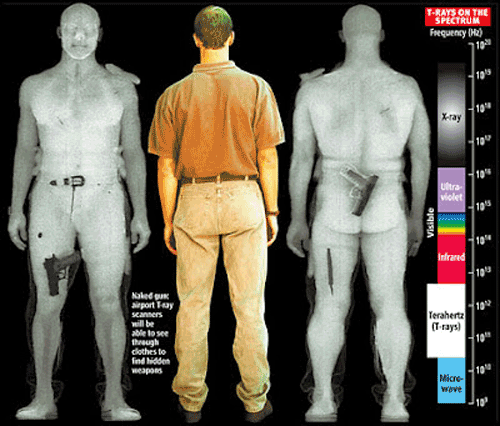Wireless data transmission reaches terahertz band
Researchers out of the Tokyo Institute of Technology have taken terahertz-level frequencies (T-rays) — the electromagnetic waves used for scanning bodies for tumors, security, etc. — and successfully used them for wireless data transmission.

Image of T-ray. (physicscentral.com)
In doing this, they achieved a transmission rate 20 times higher than the most common Wi-Fi standard used today.
As a matter of fact, the level of transmission they achieved falls between the microwave and far-infrared regions of the electromagnetic spectrum.

Electromagnetic chart.
This level of transmission has never been achieved before, and is actually not even regulated by telecommunications agencies yet.
Background
T-ray frequencies fall between 300GHz (which is about 60 times higher than the current highest WiFi standard) to about 3THz (about 10 times higher again).
They are mostly used for imaging: terahertz waves can penetrate materials just as effectively as X-rays. What’s more, they deposit much less energy than X-rays, and cause significantly less damage as a result.

T-rays used for security scan. (Via: lexx.universeii.com)
This begs the obvious question: Why are we still using X-rays? The problem with T-rays, you see, is that up until very recently, the technology required to generate and detect this frequency was too bulky, pricey, and power-hungry. That goes just the same for why they haven’t already made their way as an alternative form of frequency transmission for existing devices in smartphones and Wi-Fi routers — nobody would want to carry the bulky gadgets around, let alone be able to afford them.
What they did
The team created a 1-mm-square device centered on a resonant tunneling diode (RTD). Tunneling diodes, in general, often decrease the amount of voltage they produce as current is increased. RTDs are specially designed so that the diode instead “resonates.” With this case in particular, the group was able to use the RTD to spray out, if you will, waves in the terahertz band.
During the course of various tests with the RTD, the group was able to achieve a jaw-dropping 542 GHz, sending data through an ether at 3 Gbits/s. Granted, this isn’t as fast as the 7 Gbits/s seen with WiGig, and the bandwidth can only go a little over 30 feet away, but when it comes out of the RTD, the T-rays measure just 0.04 inches — more than small enough for an antenna in a smartphone or tablet to handle.
Researchers believe that the speed of the data transmission can be increased by using higher frequencies and power levels. They truly believe that 100 Gbits/s isn’t a pipe dream — with this technology, it could very well become a reality.
For reference, a speed that fast is nearly 15 times higher than the next-generation 802.11ac Wi-Fi standard currently in development (now that’s leapfrogging technology!)
Outlook
As for now, the team is working to improve their proof-of-principle device and extend its range deeper into the terahertz regime. They also want to increase its power output.
The technology looks promising, though, and introduces the first truly realistic future option for t-ray based handhelds; devices that would put today’s 1.3 Gbits/s of 802.11ac Wi-Fi to shame.
You can access the group’s published research via the Electronics Letters site where it is available for purchase. ■
Advertisement
Learn more about Electronic Products Magazine





